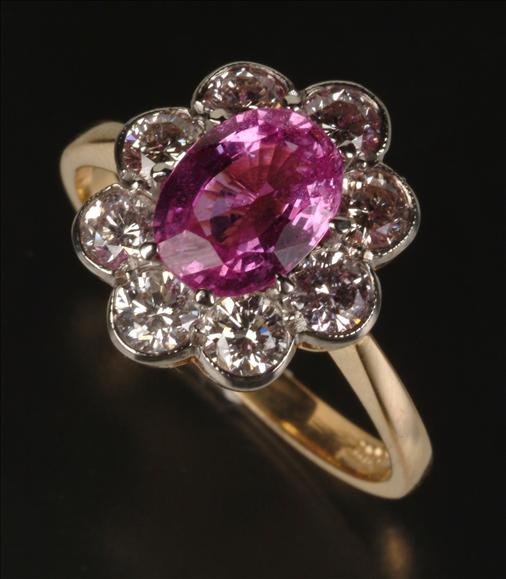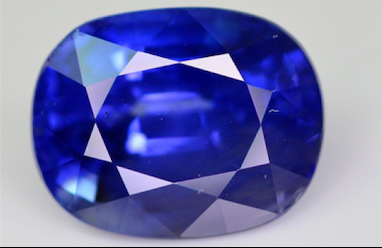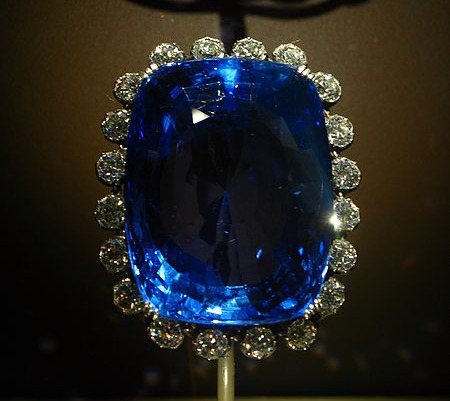
September birthstone
September’s birthstone, the sapphire, is a relative of July’s birthstone, the ruby. Both are forms of the mineral corundum, a crystalline form of aluminum oxide. But red corundum is ruby. And all other gem-quality forms of corundum are sapphires.
All corundum, including sapphire, has a hardness of 9 on the Mohs scale. In fact, sapphires are second in hardness only to diamonds.

Typically, sapphires appear as blue stones. They range from very pale blue to deep indigo. The exact shade depends on how much titanium and iron lies within the crystal structure. By the way, the most valued shade of blue is the medium-deep cornflower blue. However, sapphires also occur in other natural colors and tints – colorless, gray, yellow, pale pink, orange, green, violet and brown – called fancy sapphires. Different kinds of impurities within the crystal cause the various gemstone colors. For example, yellow sapphires get their color from ferric iron, and colorless gems have no contaminants.
It’s time for #MineralMonday! #DYK? Not all sapphires are blue. Exhibiting a spectacular range of colors, sapphire is a gem variety of the mineral corundum. Beyond blue, sapphires range from colorless to orange to green to violet, but not red—red corundum is ruby!? #NewYorkRocks pic.twitter.com/hjLvvN2bNc
— American Museum of Natural History (@AMNH) November 29, 2021
Source of sapphires
Primarily, the biggest source of sapphires world-wide is Australia, especially New South Wales and Queensland. They are found in alluvial deposits of weathered basalt. Australian sapphires typically are blue stones with a dark and inky appearance. On the other hand, Kashmir, in India, used to be a well-known source of the cornflower-blue stones. And in the United States, a major source is the Yogo Gulch Mine in Montana. It mostly yields small stones for industrial use.
Sapphire lore about the September birthstone
The word sapphire has its roots in ancient languages: from the Latin sapphirus (meaning blue) and from the Greek word sappheiros for the island of Sappherine in the Arabian Sea. That was the source for sapphire in ancient Grecian times, in its turn from the Arabic safir. Ancient Persians called sapphire the “Celestial Stone.” It was the gem of Apollo, Greek God of prophecy. Worshipers visiting his shrine in Delphi to seek his help wore sapphires. Ancient Etruscans used sapphires as far back as the 7th century B.C.
Besides being the September birthstone, the sapphire represented the purity of the soul. Before and during the Middle Ages, priests wore it as protection from impure thoughts and temptations of the flesh. Medieval kings of Europe valued these stones for rings and brooches, believing that it protected them from harm and envy. Warriors presented their young wives with sapphire necklaces so they would remain faithful. A common belief was that the stone’s color would darken if worn by an adulterer or adulteress, or by an unworthy person.
Some believed sapphires protected people from snakes. People believed that by placing poisonous reptiles and spiders in a jar containing the stone, the creatures would immediately die. The French of the 13th century believed that sapphire transformed stupidity to wisdom, and irritability to good temper.
Some famous sapphires
It's arguably the world's most famous engagement ring. Princess Diana's and now Kate Middleton's Sapphire ring. pic.twitter.com/hsDdzPHZo4
— Gemstone Creations (@gemcreations) September 15, 2021
One of the most famous sapphires rests on the Imperial State Crown worn by Queen Victoria in 1838. It resides in the British Crown Jewels in the Tower of London. In fact, this gem once belonged to Edward the Confessor. He wore the stone on a ring during his coronation in 1042, and thus called it St. Edward’s Sapphire.

Bottom line: The September birthstone is the sapphire. It is generally known as a blue gemstone, but it comes in many colors.
Find out about the birthstones for the other months of the year:
January birthstone
February birthstone
March birthstone
April birthstone
May birthstone
June birthstone
July birthstone
August birthstone
September birthstone
October birthstone
November birthstone
December birthstone











